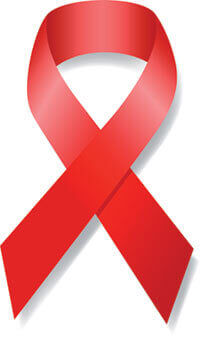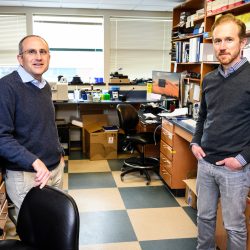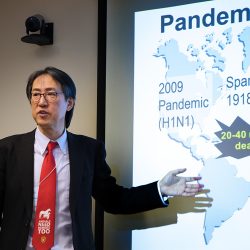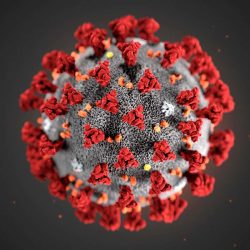HIV: Sex, Society, and Science
Pathology/Pathobiological Sciences 210
The instructors
Six UW–Madison researchers from the AIDS Vaccine Research Laboratory lead the class. Many entered the field of pathology in the 1990s, when the first antiretroviral drugs were just starting to prove their value.
The takeaway
“This is a class about HIV, but it’s also about critical thinking, about using the scientific method to conceptualize a complex problem, where students have to identify hypotheses, then test and refine them,” says co-leader David O’Connor PhD’01, who studies immune system genetics and HIV in the Department of Pathology and Laboratory Medicine in the School of Medicine and Public Health.
History of a pandemic
The students are too young to remember AIDS as the uniformly fatal disease of the 1980s and early 1990s. “We made the strategic decision to cover the history, but we really want them to understand the dimensions of the epidemic today,” O’Connor says.
HIV today
Most of the estimated 34 million people infected with HIV live in sub-Saharan Africa and other developing countries. But due in no small measure to a generous American program proposed by President George W. Bush, 8 million people around the world are getting antiretrovirals, says Matt Reynolds ’98, PhD’06, a UW associate scientist. Advances in treatment, combined with some progress in vaccines and a better understanding of how to prevent infection, have given rise to a new goal: an AIDS-free generation.
The science of infectious disease
Since the 1980s, AIDS and HIV have sparked an explosion of interest in infectious disease and immunology, says class co-leader Thomas Friedrich ’97, PhD’03 of the Department of Pathobiological Sciences in the School of Veterinary Medicine. “To understand HIV pathogenesis, scientists had to learn a lot about immunology,” especially regarding the T-cells that direct the immune system to destroy virus-infected cells, says Friedrich, who studies how viruses like HIV and influenza evolve to evade the immune system.
The future of AIDS: a cure?
Instructors, including associate scientists Dawn Dudley and Justin Greene ’05, PhD’10, discuss two people who have been “cured” of AIDS.
Although HIV can be controlled by a series of drugs, the virus is disturbingly quick to evolve. Much as bacteria are evolving resistance to antibiotics, HIV could evolve immunity to antiviral drugs and eliminate decades of progress, O’Connor says. Even though progress toward an AIDS vaccine has been painfully slow, at least one candidate vaccine has produced some protection, he says, adding, “A vaccine would truly be a transformative intervention that could eradicate HIV or dramatically limit its spread. A vaccine remains the moonshot of AIDS research.”
Influencing careers
After each semester, one or two students report that the course caused a shift in their academic and career focus. Robert Kueffer x’14, who took the class in fall 2012, says it was the reason he decided to get a global health certificate. “I have always thought I’d do business, make money, but this is something that really affects people,” he says.
Published in the Fall 2013 issue




Comments
No comments posted yet.